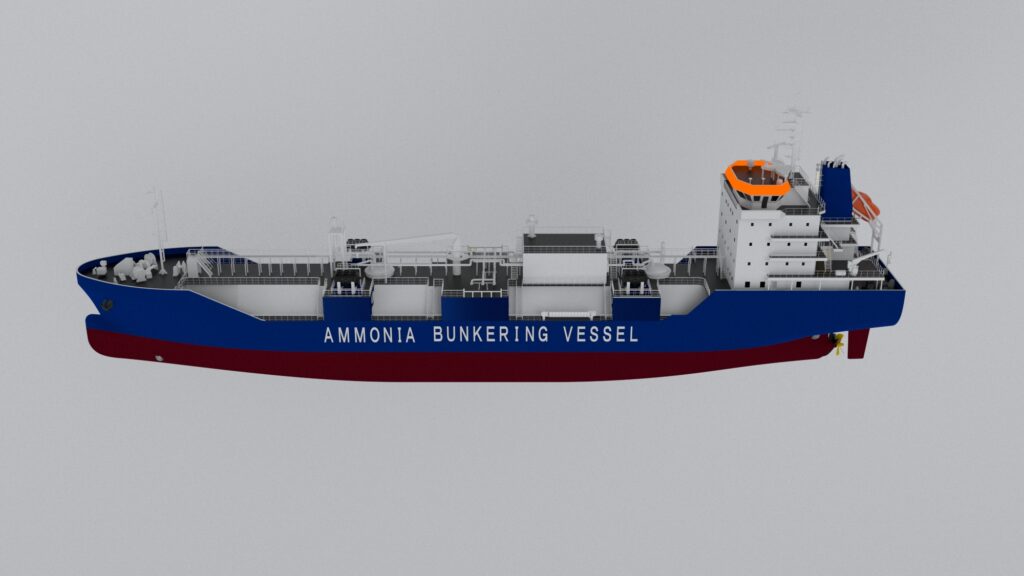ITOCHU Singapore Ammonia Bunkering Initiative
ITOCHU’s Singapore Ammonia Bunkering project is driving forward the use of clean ammonia as a marine fuel
In choosing Singapore for its ammonia bunkering initiative, ITOCHU is linking the world’s busiest port with one of shipping’s most promising clean fuels. The project is showing how early engagement with regulators, suppliers and shipyards can build confidence in an unfamiliar fuel, offering lessons for others as green ammonia markets expand worldwide.
| KEY FACTS | |
|---|---|
| Official project name | ITOCHU Singapore Ammonia Bunkering Initiative |
| Location | Singapore |
| Project stage | Early development, moving through feasibility and regulatory engagement |
| Sector | Chemicals, ammonia |
| Partners | Multiple including, the Maritime and Port Authority of Singapore, Sasaki shipbuilders |
| Total Project investment | Composing of multiple investment activities from production, bunkering and shipbuilding with ammonia as maritime fuel |
| Jobs | N/A |
| Targeted capacity | 300ktpa of low-carbon clean ammonia |
| Key milestones | • 2023 – Strategy shift towards ammonia bunkering • 2025 – Order placed for 5,000 m³ Ammonia Bunkering Vesse • Ongoing – Regulatory engagement with the Maritime and Port Authority of Singapore |
Founding vision
Historically, ITOCHU has been recognised as a Japanese trading company operating under a “product-out” approach, focusing on producing or procuring commodities and selling them through established supply chains. The Singapore ammonia bunkering initiative represents a strategic shift towards a “market-in” strategy, where the company starts by assessing future demand and builds the supply chain accordingly.
Bunkering, the refuelling of ships, is at the heart of global trade, 80% of goods traded worldwide, are transported this way. By pioneering ammonia bunkering in Singapore, ITOCHU aims to become a first mover in a fuel that is expected to play a pivotal role in decarbonising the shipping industry.
Project motivation
The Itochu team saw an opportunity to bring together different expertise and skills as an early mover. The company has an existing small bunkering subsidiary and good expertise in industrial production, allowing it to capture competitive advantage ahead of others.
The market for conventional fuels is intensely competitive. LNG currently offers better margins, but green ammonia presents a unique long-term opportunity as it is a specialised product with applications across different industries, from a maritime fuel to the production of fertiliser. It will have very few equivalent competitors once adopted as a main maritime fuel.
Methanol, an alternative contender for clean shipping fuel, is easier to handle, but ITOCHU believe scaling its low-carbon clean production to the volumes needed (400-500 mtpa by 2050) remains challenging. By contrast, (grey) ammonia is already traded globally and low-carbon clean ammonia offers potential for larger volumes with easier standard compliance, making it a suitable option for long-term shipping decarbonisation.
ITOCHU’s strategy begins with demand. Singapore is the world’s largest bunkering hub and wants to maintain its leadership position. By engaging with this market and anticipating future needs, the company aims to create a tipping point for demand through the ease of use of clean ammonia fuel, thereby incentivising the maritime sector to adopt low-carbon clean ammonia on a large scale. This approach contrasts with conventional strategies that focus initially on production capabilities, reflecting ITOCHU’s forward-looking, market-driven philosophy.
The Maritime and Port Authority of Singapore is demonstrating very strong leadership and ambition in its commitment to utilising low-emission marine fuels.
— Hiroyuki Tsubai
Executive Vice President, Member of the Board, Deputy COO, President of Machinery Company
Production and bunkering strategy
The Singapore bunkering project forms part of a broader integrated ammonia strategy that ITOCHU is currently developing. Bunkering facilities for green ammonia will need to be present around the world if the global maritime industry is to seriously adopt the fuel. The company is actively considering bunkering projects in Japan, European ports (including the Port of Algeciras) and the Suez Canal to serve the European market and Panama for the American continent. A global ammonia bunkering network will also require developed production sites to supply the clean fuel, which ITOCHU intends to establish.
To support their Singapore bunkering ambitions, the company is developing a pilot project in Indonesia, utilising idle capacity in an existing grey ammonia plant through the use of green hydrogen, which allows for testing with limited investment and is aided by the Japanese government’s ‘Global South Future-Oriented Co-Creation Project’ grant. This is expected to reach final investment decision (FID) in the coming months and be fully operational by 2027 with a capacity of around 50 ktpa.
A new commercial scale green ammonia project to serve the Singaporean bunkering market is planned in India with an expected capacity of 300 ktpa. The developed engineering design is modular, allowing expansion for up to five units on the site and similar projects to be developed in other regions. ITOCHU anticipates that, depending on market conditions (i.e. the number of new ships built), this project can be scaled up to produce 1.8 mtpa, with FID expected in the next 12 months and commissioning scheduled for 2029.
ITOCHU is anticipating customers to come from bulk carriers and those with high value freight where any cost impact will be relatively low for the end consumer, such as the car market and container market.

Benefits of being a first mover
Entering the ammonia bunkering market early offers several strategic advantages:
- Credibility with regulators and authorities: Demonstrating safety and operational competence from the outset builds trust and influence, which is crucial in a high-risk industry.
- Technical expertise and operational know-how: First movers gain valuable experience that is difficult to replicate, creating a competitive barrier.
- Market leadership: Establishing safety and operational procedure early on enables ITOCHU to influence the emerging supply chain, ITOCHU convened 34 companies with a stake in maritime operations for a joint workshop and study.
- Securing early partnerships: Securing early strategic partnerships creates durable long-term relationships. ITOCHU has been in conversations with port authorities, shipbuilders, container liner operators and other stakeholders key to potential ammonia bunkering.
- Long-term cost and risk advantages: Experience with safety, logistics and regulatory compliance reduces future operational and investment risks.
Challenges
Although the opportunities are significant, pioneering ammonia bunkering involves substantial risk, stemming from the technical complexity of ammonia as a marine fuel, the ever-evolving regulatory landscape, and the uncertainties surrounding market adoption. ITOCHU faces five major challenges:
- Safety and perception: Ammonia is toxic – demonstrating safety to regulators, stakeholders and the public is crucial. Multiple studies and workshops have been conducted.
- Regulatory uncertainty: IMO rules on clean fuels are still evolving, and penalties for fossil fuel use and incentives for low-emission alternatives are yet to be finalised. Uncertainty surrounding definitions, certification and subsidy mechanisms poses a risk to investment and planning.
- Technology readiness: Ammonia engines and bunkering vessels are emerging technologies. ITOCHU must navigate these untested operational systems and coordinate with suppliers, shipyards and equipment manufacturers to ensure that the technology can be used on a large scale.
- Market uncertainty: Methanol and LNG may be adopted faster than ammonia in certain sectors, leaving ammonia behind if uptake is too slow.
- Global supply chain integration: Establishing an ammonia bunkering ecosystem requires close coordination with clean energy producers, technical specialists, shipbuilders, engine manufacturers and international and national authorities – an unprecedented scale of integration.
Without well-established regulations, the label “clean ammonia” offers no certainty or differentiation.
— Hiroyuki Tsubai
Executive Vice President, Member of the Board, Deputy COO, President of Machinery Company
Lessons learnt:
The initiative is still at an early stage, but several lessons are emerging:
- First movers gain credibility: Demonstrating safe operations and engaging with regulators early on builds trust, lowers barriers and allows influence over industry standards.
- Flexibility is vital: Starting with smaller-scale operations in Singapore and using existing grey ammonia facilities in Indonesia reduces risk, while preparing for future expansion to clean ammonia supply in markets like India.
- Partnerships are the foundation to success: Engagement with regulators, suppliers, financiers and shipyards is as important as technical progress. Integrating these actors into a coherent ecosystem is central to success.
Looking ahead
Singapore’s ammonia bunkering initiative is a test case for how new marine fuels can be introduced across the world. If successful, the project will not only secure Singapore’s role as a clean fuel hub, but also demonstrate a replicable model: anticipating demand, creating safe infrastructure and building credibility to draw in global supply. By moving first and building up its own integrated production capacity, ITOCHU can drive the take-up of green ammonia and help accelerate maritime decarbonisation. ITOCHU has plans for global bunkering operations, stretching from Japan, Singapore through the Suez Canal to the European ports and beyond.

